Dec 20, 2025
Dec 20, 2025
by Kumud Biswas
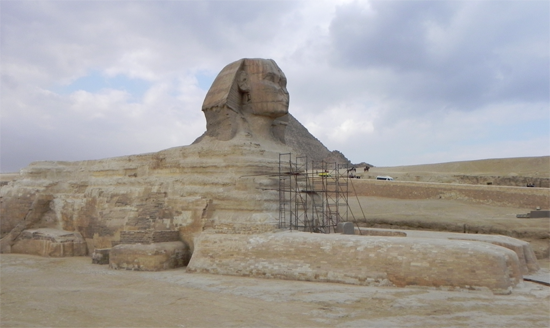
On the 4th of January 2011, last on my second leg of journey from Calcutta to Cairo at Dubai a fellow traveler sitting on my left was a boy of about 15. He was watching the anime TV serial megamind on the video screen with rapt attention. But as I started a conversation he readily responded. His name was Mohammed. His father, a small scale manufacturer at Cairo, had admitted him in an American school at Dubai. He spoke English fluently and wanted to be a pilot. When he learnt that I was going to his country to visit my daughter who is learning Arabic in the American University at Cairo he told me that he could speak but could not read or write his mother tongue Arabic. He appeared to know very little about India excepting the friendly relation existing between the two countries since the days of their national hero Nasser. [I was to learn very soon how Bollywood films have captured the Egyptian mind and our heroes and heroines – specially Amitabh, Shahrukh and others - have become household names.] About his own country however I found Mohammed quite well informed – with its huge earnings from tourism, oil, natural gas, the Suez Canal etc their country was quite prosperous but prices of essential commodities were spiraling, unemployment was high and it was rife with corruption. A few were very rich while the majority of the common people were very poor. He also mentioned an incident about which he was worried - the bombing that took place on the New Year’s Eve in a Coptic church at Alexandria which killed about 30 people.
The reception of the tourists by the Egyptian immigration and customs officials at Cairo airport appeared to be quite friendly. A customs officer enquired about the content of only one item of my luggage - a carton I was carrying. He was amused when I told him that it contained about ten kilograms of fried fish for my daughter – hilsa, rohu, katla, bhetki, bagda prawn etc, the delicacies the Bengalis love most. Fortunately it was not an entry point either in the UK or USA. The effrontery and arrogance of the officials of those countries towards the Afro-Asian travelers in particular is well known. The current war on terror has given them an additional excuse to be rude. (Have you forgotten the cases of Shahrukh Khan and our ambassador in the USA?) My daughter had come to the airport to receive me. Mohammed was received by none of his family members but by a few of his friends of the same age as his.
Where my daughter stays is called Zamalek. It is an island in the river Nile and is known as the Embassy district because most of the foreign embassies are located here. Next morning I saw the famous Nile glimmering only a few hundred feet away in the east and a low mountain range dimly visible in the horizon near where stand the three famous Pyramids and the Sphinx. My carrying so much of load was not taken very kindly by my daughter. In the evening she therefore took me to a big department store well stocked with fruits, vegetables, fish, meat, milk and cereals to convince me that she was not starving. And the Egyptian cooking is heavenly because they love to eat. It is a pleasure to eat in a restaurant – best of all are those on the boats lining along the banks of the Nile. Best time is after evening when you may be treated with something unique - belly dancing of beautiful Egyptian damsels. Before you leave don’t miss a few puffs at a sheesha selecting tobacco of any of the many flavors you want to smoke. Many Egyptians – both male and female – indulge in it openly in the public during all hours of the day.
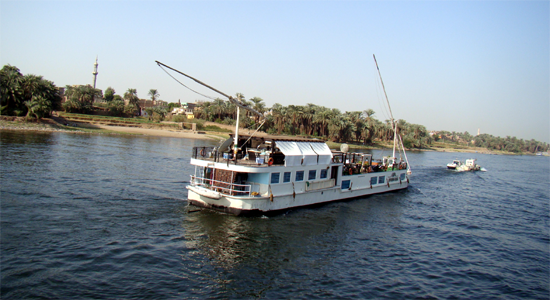
I had upset my daughter by not accompanying her mother earlier to avail of the Nile cruise arranged by her university. This is something no tourist should miss. I told her not to worry – I would be happy with a felucca (a small sailing boat) ride on the Nile. She gave me a guide book on Egypt to plan my itinerary. I told her to do it herself. Instead of a professional guide I wanted her to be my guide and spare only her weekends. She has picked up Arabic quite well and without it you cannot move in Egypt. On the 6th she took me to the Museum. No description is adequate to give an idea how wonderful it is. Everything is on a grand scale. Housed here is a civilization which flourished thousands of years ago when most of the rest of the world was in a primitive state of existence. Artefacts are displayed in a chronological order representing the various dynasties and kingdoms and Pharaos. Most impressive is the extensive section on Tutankhamen. His mask, an exquisite work of art, placed in the centre of a room, is made of solid gold weighing 11 kilogrammes. The mummified body of this boy king was buried in three sarcophaguses, one within the other – the innermost one is the smallest and is covered with exquisitely worked plates of beaten gold. There is so much to see! You need at least a week, if not more, to see it properly. For lack of space many articles are said to have been kept in a vast cellar of the Museum – all of them waiting to be put on display in an ambitious complex with modern arrangement for their preservation planned near the Giza pyramids at a huge cost. Construction is however yet to start. Egyptians are very proud of their past. Their famous Museum is not a collection of articles plundered from other lands – they are their very own. On the contrary much of the relics of their ancient civilization have been plundered by the western world.
On the 8th we went to Giza; by taxi it is about half an hour’s journey from Cairo and cost us 25 Egyptian pounds. It was cloudy and there was a very high wind. I read about this wind in Herodotus’s account of Egypt Euterpe – it is characteristic of the Nile. Now my first hand experience convinced me that it is really unique.
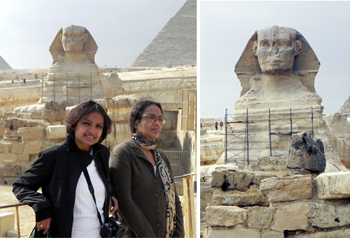 The three pyramids of Giza are the three massive structures built by the ancient Egyptians – of the seven wonders of the ancient world they are still standing in their majesty with the mysterious Sphinx as their gatekeeper. They are said to have been built in alignment with certain celestial bodies. It is an engineering marvel of the ancient world. The largest of them, the pyramid of Khufu, is built of more than 2,000,000 blocks of stone. It is a mystery how these huge blocks, cut in perfect shapes weighing about 2 tons each, were transported from far away places across the desert and placed one upon the other to such a great height! It was the tallest structure in the world for more than 4300 years.
The three pyramids of Giza are the three massive structures built by the ancient Egyptians – of the seven wonders of the ancient world they are still standing in their majesty with the mysterious Sphinx as their gatekeeper. They are said to have been built in alignment with certain celestial bodies. It is an engineering marvel of the ancient world. The largest of them, the pyramid of Khufu, is built of more than 2,000,000 blocks of stone. It is a mystery how these huge blocks, cut in perfect shapes weighing about 2 tons each, were transported from far away places across the desert and placed one upon the other to such a great height! It was the tallest structure in the world for more than 4300 years.
The Sphinx, said to be of the height of a six-storey building, looks like a pigmy by the side of these pyramids. So many kingdoms and empires have risen and fallen but these huge bodies still proclaim the glory of the ancient Egyptian civilization. One must see them with one’s own eyes to feel the sense of awe and wonder that they inspire. Not least interesting is the air-conditioned boat house built to house the re-assembled boat found buried beside the pyramids.
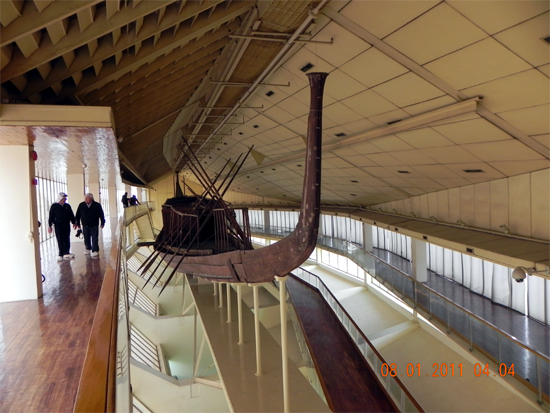
The Nile flowed not very far from Giza in ancient times. When the river was in high tide the place was accessible by boat. And the buried boat must have been the means of transport to the Pharaos and their followers who came on ceremonial occasions to the temples of Giza. Further south near Memphis, the site of the ancient capital city of Egypt, are visible three more Pyramids hazy in the horizon. They are the Step Pyramid of Zoser at Saqqara and the Red and Bent Pyramids of Dahshur. They predate the Giza pyramids and are said to represent the formative stages of architecture that reached perfection in the great pyramid of Khufu. Though situated at a distance of about three hours’ camel ride across the desert from Giza (must be an exciting journey indeed!) we postponed their visit to another day because of bad weather. They are not very far from Cairo by road. They are a must-see for those who want to learn more about the architectural aspects of the pyramids.
We planned our next visit to the city of Alexandria on the twelfth. I was in two minds because of the tensions which had been building there since that New Year eve bombing in a Coptic church. During the past few days the weather had been deteriorating – the temperature had dropped very sharply and there was a very high wind. In the papers the weather office had published a warning – unless absolutely necessary none should venture out of his home till the weather improved. We had to cancel our plan and remained home-bound.
The day of my departure scheduled on 2nd February was drawing near and after the recess my daughter’s university was also to open shortly. As soon as the weather somewhat improved on the 21st we therefore went to visit the most famous remains of ancient Egypt at Thebes, now called Luxor - the temples at Luxor and Karnak and the Valleys of the Kings and the Queens. There is nothing in the world which can come close to the grandeur of this place. To the south of Cairo it is about one hour’s journey by air.
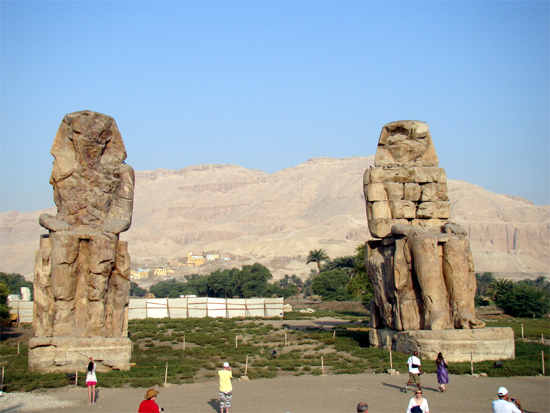
We reached there very early in the morning. My daughter had hired a local guide and a luxury car to take us around. First we went to the Valley of the Kings on the west bank of the Nile. On the way we saw the two majestic Colossi of Memnon, the legendary African king who was slain by Achilles during the Trojan War. They are a great tourist attraction and the only remains of the largest temple of ancient Egypt built by Amenhotep III, believed to have been larger than the Karnak temple complex. In the Valley of the Kings there are 63 tombs dug underneath the mountains where were laid the mummies of the Kings, many cubicles reserved for their near and dear ones. The engravings and murals on the walls and ceilings are testimonies to the high artistic skills attained by the ancient Egyptian craftsmen. In carved hieroglyphs they have also left the imperishable records of their stories – and Egyptians are credited to be the earliest inventors of the art of writing.
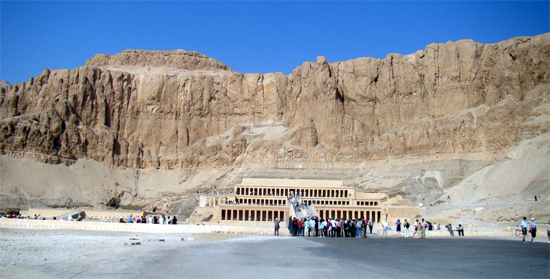
On the other side of the Theban hills where the Valley of the Kings is located lies the Valley of the Queens where Deir al-Bahri, the temple of Queen Hatshepsut, is most famous. This queen ruled in the guise of a male king. The front colonnade consists of a row of her huge stone statues wearing beards. The roofs are missing. Inside on the walls now in ruins are recorded in hieroglyphs the narratives of her campaigns and achievements.
After a short lunch break we went to see the temple complexes of Luxor and Karnak the likes of which are nowhere to be seen. They are situated side by side on the eastern bank of the Nile and were originally connected by a magnificent avenue of sphinxes which ran straight from the banks of the river. Later developments which encroached upon this avenue are being removed and the restoration work is in progress. It is beyond my powers to describe the majesty and magnificence of these priceless heritages of the ancient Egyptian civilization. Everything is on a gigantic scale and makes you speechless in awe and wonder.
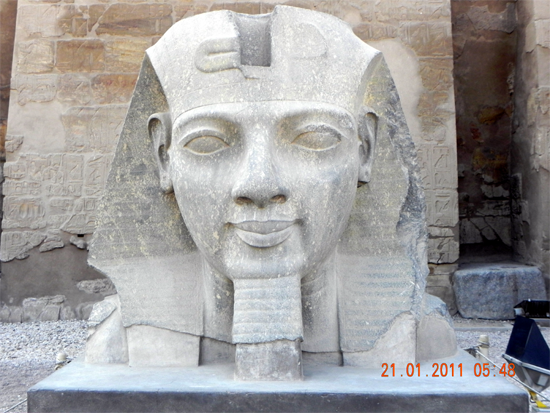
At the entrance at Luxor, after crossing the court, you are stupefied by the sight of the gigantic head of Pharao Rameses II. Cut out of a single block of stone of huge size it is the perfect witness to the supreme artistic skill attained by the ancient Egyptian artists whose names are completely forgotten today. Luxor is given mainly to the display of the achievements of the great Pharao Rameses II, while Karnak is the abode of god Amun.
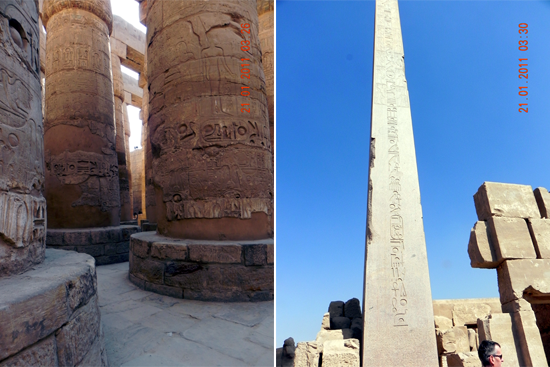
The latter site covers over 2 sq km, large enough to contain about 10 cathedrals and the temple of Amun is reputed to be the largest religious building ever built. It is so vast and various that after a short visit of only few hours you get confused and feel lost in the midst of its many pylons, courts, kiosks, halls, columns and obelisks, all of them on a grand scale. Most awesome is the Great Hypostyle Hall beyond the second pylon which covers 5500 sq metres – enough to accommodate both Rome’s St Peter’s Basilica and London’s St Paul Cathedral. It is a veritable forest of 134 towering papyrus-shaped stone pillars, so magnificently photographed in the film Death on the Nile!
The size of these pillars and their exquisite decorations are overwhelming. The roofs are missing and after the ravages of time and of successive invasions much of the magnificent structure are in ruins. Many of the artefacts have also been plundered. For example one of its monolithic obelisks now stands in the Place de la Concorde in Paris. What a 19th century writer and artist, Amelia Edwards, wrote about this site is worth quoting – ‘It is a place that has been much written about and often painted; but of which no writing or art can convey more than a dwarfed and pallid impression ….. The scale is too vast; the effect too tremendous; the sense of one’s own dumbness, and littleness, and incapacity, too complete and too crushing.’ In my humble opinion this is the one place on earth that one must see before dying.
When we were back to Cairo it was midnight. The weather was still bad – the wind was high and cold, there was a drizzle at Cairo where it never rains, the roads were less crowded, the cruise ships and feluccas were anchored and were lying idle; the sounds of songs and dances coming from the floating restaurants well past midnight were now silent. My days were numbered and I was yet to see many things. My daughter had got her mother’s two weeks’ tourist visa converted into a five month long multi-visits visa. So I had no reason to lose heart. Man proposes but God disposes!
From the day after next she had to attend office from early morning till midnight. Thousands of Indians were to be evacuated from Egypt. That country had caught an infection from the adjoining state of Tunisia. There the self-immolation by a street vendor, an educated unemployed youth, had snowballed into a countrywide antigovernment protest of such magnitude that its President had fled the country. Similar stray attempts of self-immolation by some Egyptians at Cairo and Alexandria had been prevented by the local administration. But from the 25th crowds of Egyptians defying inclement weather began to converge on the Tahrir square from all directions to protest against their President Hosni Mubarak. He had been ruling Egypt with an iron hand for long thirty years. Now he must go. He was corrupt and a tyrant. The Egyptians must have democracy.
Clashes between the protestors and the police took place at various places, some police outposts were set on fire, there were some casualties on both sides, the head office of the ruling party was also gutted. From the building where I was staying I could see the processions of protestors passing, the tear gas shells bursting and clouds of smoke billowing. An indistinct low noise could be heard coming from the distant crowd. The police and the prison guards soon abandoned their posts throughout the country and the criminals and convicts broke out of the jails free.
Before looting and vandalism could become rampant the army clamped down curfew and began to patrol the capital in their cars and helicopters. Many of the criminals were re-arrested. All TV channels and the internet were blocked. People did not panic but formed vigilante parties to patrol their neighbourhoods.
At the Tahrir square the agitators squatted pitching makeshift tents and putting up barricades. They demonstrated peacefully appealing not to become violent or resort to vandalism and wanton destruction of public properties. No roads were blocked. A posse of army officers and cadets stood by with a tank and some armoured cars to stop the agitators’ march towards the state administrative headquarters. They never used force. To me an Indian and that too a Bengali it was a unique experience.
The pot-bellied Calcutta police enjoy a sadistic pleasure in lathi-charging peaceful demonstrators. To protest against the tram fare hike by only one paisa how many trams and buses were burnt on the streets of Calcutta by our redoubtable revolutionaries Jyoti Basu and Buddhadeb Bhattacharya? How many times every month these public leaders paralyse the whole country by their frequently called bandhs? To enforce these bandhs on the unwilling populace how much public property they destroy, how many they maim or kill every time?
Any way I came back to my city of processions Calcutta by the scheduled flight; the Egypt Air had suspended its flights but the Airport had not been closed and other international airlines were running their flights as usual. On my way to the airport when the agitation was at its highest I had passed by the Tahrir Square without let or hindrance. At the airport the Indian embassy officials were running a roadside counter to assemble their stranded countrymen for evacuation. My friend Pradip Bhattacharya made a trip to Egypt before me and its ancient civilization has now become one of his obsessions. He has become restive for another trip. I seem to have caught the infection. Shall I be able to resume its exploration so abruptly cut short this time by a unique upheaval of modern day Egypt? To find a passage to this mother of civilizations I cannot bypass modern Egypt – I will have to pass through it.
Cotinued to "Reflections on my visit to Egypt"
17-Mar-2011
More by : Kumud Biswas

|
Dear Ms Gupta. Happy to know you enjoyed you trip, but did you smoke sheesha? |

|
Excellent article! Made me re-live the wonderful experience of my 2004 trip to Egypt, when among other things, we visited many of the places you mention - the Valley of the Kings, Karnak, Luxor and Giza. We also took the Nile cruise and visited the relocated Abu Simbel temples (amazing in themselves, but amazing also in the engineering skills involved in the relocation). Egypt is truly magical! MG |

|
Dear KC, I know you love to travel. Please go to Egypt, you will enjoy your tour, I assure you. There are so many places and things to see and so many myths and legends are associated with each of them that it is next to impossible to give all the details. The present write up is only an expression of joy I derived from my very short visit under very disturbed conditions. Thanks for reading and commenting. |

|
Great piece Kumud-da. I feel as if I've visited Egypt in misty dreams [ie all details are not clear but I've got a sense of having been as an armchair traveller from your piece, and it's vivid]. KC |

|
The point is well taken Mr.Ashby. My visit to the past of Egypt was cut short by its present turbulence of which I propose to talk in my second instalment. |

|
Thank you for an entertaining account, but the following will interest you. I had early observed that the glory in scenery, architecture, and cultural manifestation of any country is a tourist thing. And it is admitted as such, and enshrined in the tourist industry. As in your account, it is the visiting foreigner who goes about 'ooh-ing' and 'aah-ing' - but the locals have a different perception, one in which the objects of glory are part of the daily scene, are homely. It was as a schoolboy in Darjeeling that I viewed Kanchenjunga every day, and it was part of the background, and was of homely appearance. Only in the eyes of visiting tourists was it a thing of awe: they would 'ooh' and 'aah', excitably take photos, and depart, no doubt preserving the awe in memory. I even remarked to a friend as to our feeling no comparative thrill in the very same sight; because to us it was a homely sight. The tourist appreciation of a place is indeed at a remove from the people who live there, which seems a curious thing. It makes one realise how false one's perception is - as a tourist: even in honest self-gratification! In fact, whoever we are, we identify as a homely background the defined to be glorious aspects of our home surroundings, be they the Himalayan peaks or the pyramids of Egypt; and, as locals, we are far more agitated about improving our standard of living and preserving our freedom. Which brings us to the events in Tahrir Square by people who are exactly the same as we are in their priorities, and for whom all the glories of Egypt are homely in appearance. I suppose the whole tourist industry then is a fantasy trip - well, what's new? |

|
Thank you Mouri for reading and commenting. I shall thank you more if you visit Misr as soon as things become normal there. It is a wonderful place and, as I said, one must see it before dying. |

|
Enjoyed the travelogue very much! As also the anecdote about the ten kilos of fried fish! Your daughter must have been livid! The photographs were excellent too! I guess this holiday will always remain your most memorable - because you also witnessed history in the making! |

|
Dear Dr. Mallick, Many thanks for the compliments. You are absolutely right - both the Nile and the Ganges are the highways respectively of the Egyptian and Indian history and culture. Visits to them are a kind of pilgrimage. |

|
Dear Dipankar, I had the rare opportunity to see history being made by the Egyptian people. When hundreds and thousands of Egyptians were gathering in the Tahrir square my first thought was - has Muhammed, the boy I had met on the plane - joined the agitators along with his friends? This young generation is the future not only of Egypt but also of the entire Arab world. Let us see what course this movement takes. Let us hope for the best. As for your visit to the districts of Bankura and Purulia I expect something from you which will open our eyes - their backwardness and the deprivation of the underpriveleged people of those places neglected for ages. About 40 years ago I was in Bankura as a trainee and I know at first hand how we have neglected the tribals for ages. We treat them as sub-human creatures. Io me this seems to be the root cause of this Maoist revolt. The way we are handling it is by no means democratic. We can hardly blame Gaddafi. |

|
A gem of a write-up, Kumud babu. Hats off to you. You have almost put me in a houseboat in the Nile that evolkes in us the same feelings as of the Ganges! Thank you. |

|
Kumud-babu: I knew you were in Egypt during the turmoil and was somewhat worried. But I was also expecting this travelogue from you. I had little doubt before you left India that, being a sensitive person, you would be coming back with a bagful of treasure. An unfair exchange this was in my opinion. Ten kgs of fried fish were all you had to offer to Egypt and that too for the consumption of your daughter and wife (perhaps some friends too). But Egypt gave you so much more. You are sharing it with the entire boloji community free of charge. I am quite sure that we got more out of all this than the Egyptians did! Quite clearly, you covered a lot of ground during your short stay. While you were away in far off Egypt, I was travelling through the districts of Bankura and Purulia trying to figure out the nature of the problem that has been plaguing this state. It was first hand experience and I gained a great deal from it. I even visited an area that is said to be under Maoist control on a day they had declared a bandh. Perhaps I was over-zealous in my quest, but I did end up learning a lot about my own land. I came back with the feeling that most of my life I have been living in a frog's well. Best wishes. |